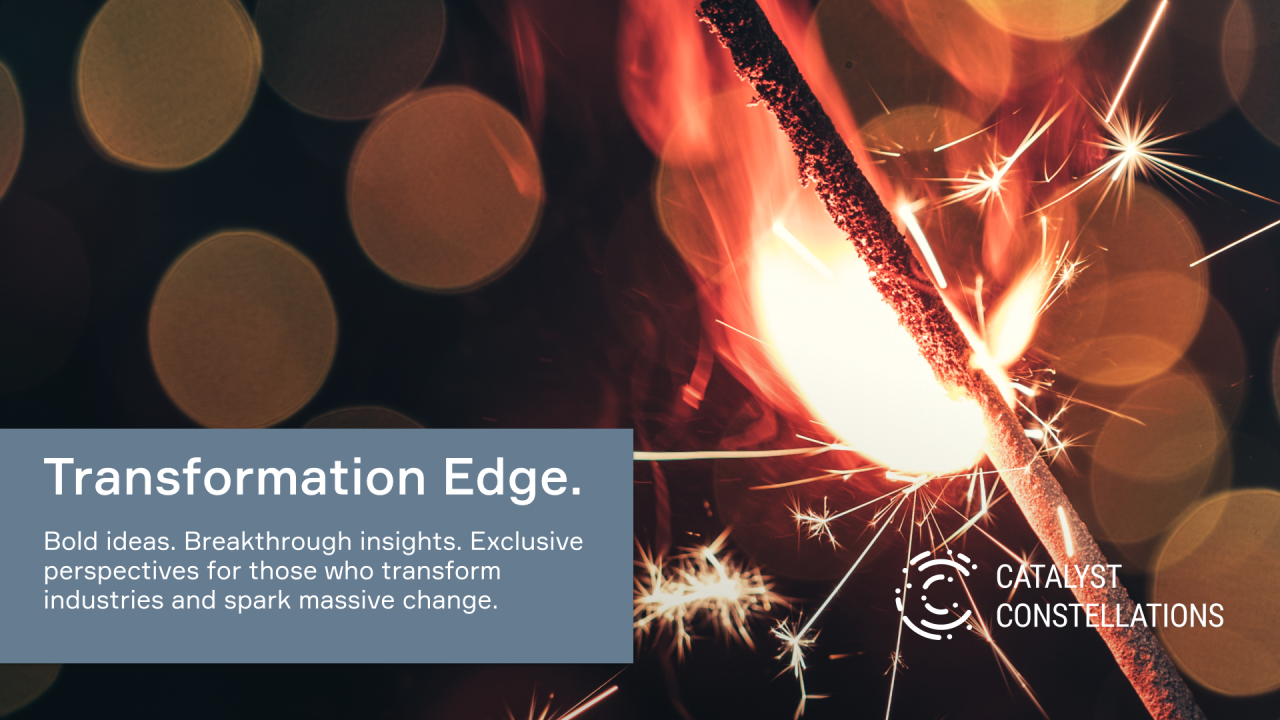


Shannon Lucas
May 26, 2025
Key Takeaways:
Breaking Through Organizational Inertia
Innovation isn't stalling because of idea quality—it's failing at the critical moment of organizational adoption. How can you not just spark innovation, but scale it?
Michael Arena, PhD (Dean of Crowell School of Business and former executive at GM, Amazon, and Bank of America) recently shared research with our Catalyst Leadership Trust that confirms much of what we’ve seen at Catalyst Constellations: disruptive change is as much about who you engage—and how— as it is about the brilliance of the idea itself.
When Innovation Cashes Out: Lessons from Bank of America
Arena’s own journey began at Bank of America, where he co-led the Center for Future Banking. With support from MIT Media Lab, his team developed five promising ventures, some of which went on to generate billions in revenue. But here’s the kicker: none of those innovations were adopted by Bank of America.
This failure led Arena to ask: What really enables innovation to take root inside complex organizations?
The Answer: Social Bridging
After analyzing 60 innovations across companies like Adobe, IBM, and Google, Arena’s research uncovered a clear pattern: successful innovation wasn’t about better ideas. It was about better networks.
The differentiator? Executives who strategically positioned themselves as network bridges across organizational boundaries. Steve Jobs exemplified this approach, sitting at the center of Apple's patent network—not with the most connections, but with the right ones that connected otherwise isolated innovation clusters.
“It may have been Steve Jobs’ network, not just his genius, that made him a great innovator,” said Michael.
Three Phases of Innovation: Three Opportunities to Influence
Arena’s work breaks innovation into three phases - Discovery, Development, and Diffusion - each requiring a different network structure and leadership approach.
1. Discovery: Break the Bubble
$2.3 trillion has been wasted globally on unsuccessful transformations. To avoid this fate:
2. Development: Shield Your Catalysts
This is where ideas transform into testable prototypes. This phase is about momentum, not consensus, so your focus will be on giving the innovation team the space they need to bring the idea to life.
3. Diffusion: Build Trust Networks, Not Just Rollouts
This is the make-or-break phase where most innovations die. Your team has been living and breathing these ideas for weeks, maybe months. It’s hard to understand why everyone doesn’t immediately “get it,” so your role is critical:
Transform Your Innovation Approach Now
Organizations that master these network dynamics don't just create innovations—they create transformation engines that continuously adapt to market shifts.
Join executives from Chobani, TIAA, CBRE and other forward-thinking organizations in the Catalyst Leadership Trust, where we're building the next generation of transformation leaders. https://mc.catalystconstellations.com/cltfullbrochure
Ready to unleash your organization's hidden Catalysts? Contact us to learn how we've helped companies achieve measurable results on their boldest strategic initiatives.
- The majority of transformation initiatives fail because they lack the right network strategy across discovery, development, and diffusion
- Place innovators at the edges for discovery, in focused teams during development, and leverage them as bridges during diffusion
- Create horizontal momentum through peer networks before formal rollouts to overcome organizational resistance
Breaking Through Organizational Inertia
Innovation isn't stalling because of idea quality—it's failing at the critical moment of organizational adoption. How can you not just spark innovation, but scale it?
Michael Arena, PhD (Dean of Crowell School of Business and former executive at GM, Amazon, and Bank of America) recently shared research with our Catalyst Leadership Trust that confirms much of what we’ve seen at Catalyst Constellations: disruptive change is as much about who you engage—and how— as it is about the brilliance of the idea itself.
When Innovation Cashes Out: Lessons from Bank of America
Arena’s own journey began at Bank of America, where he co-led the Center for Future Banking. With support from MIT Media Lab, his team developed five promising ventures, some of which went on to generate billions in revenue. But here’s the kicker: none of those innovations were adopted by Bank of America.
“Why didn’t these great ideas – ideas that made others billions – get adopted? The organization’s "antibodies" rejected them.” - MichaelDespite executive approval, investment, and press buzz, these ideas were killed by internal resistance. The not-invented-here mindset, entrenched silos, and risk aversion snuffed out innovation at the exact moment it needed organizational support to scale. A scenario familiar – and frustrating – to us Catalysts.
This failure led Arena to ask: What really enables innovation to take root inside complex organizations?
The Answer: Social Bridging
After analyzing 60 innovations across companies like Adobe, IBM, and Google, Arena’s research uncovered a clear pattern: successful innovation wasn’t about better ideas. It was about better networks.
The differentiator? Executives who strategically positioned themselves as network bridges across organizational boundaries. Steve Jobs exemplified this approach, sitting at the center of Apple's patent network—not with the most connections, but with the right ones that connected otherwise isolated innovation clusters.
“It may have been Steve Jobs’ network, not just his genius, that made him a great innovator,” said Michael.
Three Phases of Innovation: Three Opportunities to Influence
Arena’s work breaks innovation into three phases - Discovery, Development, and Diffusion - each requiring a different network structure and leadership approach.
1. Discovery: Break the Bubble
$2.3 trillion has been wasted globally on unsuccessful transformations. To avoid this fate:
- Inspire yourself and others with “Think Big” challenges, but clearly define “big”
- Move innovation teams to organizational edges—like GM did by sending teams into urban centers to understand mobility beyond traditional truck buyers
- Resist micromanagement—discovery requires freedom, not oversight
2. Development: Shield Your Catalysts
This is where ideas transform into testable prototypes. This phase is about momentum, not consensus, so your focus will be on giving the innovation team the space they need to bring the idea to life.
- Form autonomous, cross-functional teams with minimal dependencies - like Amazon’s famed “two-pizza” teams
- Maintain organizational distance while providing resources and air cover
- Keep exploration informal—premature executive visibility creates unnecessary pressure
3. Diffusion: Build Trust Networks, Not Just Rollouts
This is the make-or-break phase where most innovations die. Your team has been living and breathing these ideas for weeks, maybe months. It’s hard to understand why everyone doesn’t immediately “get it,” so your role is critical:
- Activate peer influencers first—what Arena calls "energizers"—who can validate innovations horizontally
- Create informal showcases to build organic excitement—GM used "Innovation Showcases" with beer and popcorn. No formal agenda—just demos and conversation. As Arena jokes, “It takes a few beers to make great wine.”
- Remember this is co-creation, not selling—encourage your team to validate the innovation with the skeptics in their organization, and to not just listen but learn.
Transform Your Innovation Approach Now
Organizations that master these network dynamics don't just create innovations—they create transformation engines that continuously adapt to market shifts.
Join executives from Chobani, TIAA, CBRE and other forward-thinking organizations in the Catalyst Leadership Trust, where we're building the next generation of transformation leaders. https://mc.catalystconstellations.com/cltfullbrochure
Ready to unleash your organization's hidden Catalysts? Contact us to learn how we've helped companies achieve measurable results on their boldest strategic initiatives.

Developing Your Next Generation of Change Leaders
#article
Mentoring a Junior Catalyst isn't just talent development—it's protecting a valuable organizational asset. These change agents see possibilities others miss and drive toward those possibilities...
May 20, 2025
|
Shannon Lucas

Building Your Unique Culture of Innovation
#article
The term "innovation" often becomes a catch-all that fails to drive real business impact. The most successful organizations define innovation precisely to deliver their corporate...
May 13, 2025
|
Shannon Lucas

Navigating Change? Start with Your Network
#article
As Catalysts, we're wired for action. We see the problem, envision the solution, and want to sprint toward it. But cutting across silos and hierarchies...
May 05, 2025
|
Shannon Lucas